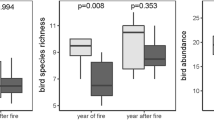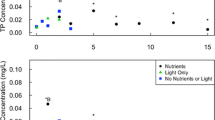Abstract
The effects of fire on wetland vegetation in the mid-Atlantic region of the United States are poorly known, despite the historical use of fire by federal, state, and private landowners in the Chesapeake Bay Region. Prescribed fire is widely used by land managers to promote vegetation that is beneficial to migratory waterfowl, muskrats, and other native wildlife and to reduce competition from less desirable plant species. We compared vegetative response to two fire rotations, annual burns and 3-year burns, and two control sites, Control 1 and Control 2. We tested the effects of fire within six tidal marsh wetlands at Blackwater National Wildlife Refuge and Fishing Bay Wildlife Management Area in Maryland. We examined changes in total live biomass (all species), total stem density, litter, and changes in live biomass and stem density of four dominant wetland plant species (11 variables). Our results suggest that annual prescribed fires will decrease the accumulation of litter, increase the biomass and stem densities of some wetland plants generally considered less desirable for wildlife, and have little or no effect on other wetland plants previously thought to benefit from fire.





Similar content being viewed by others
References
Blackwater National Wildlife Refuge (2000) Fire Management Plan. US Department of Interior Fish and Wildlife Service, Cambridge
Bray MP (1984) An evaluation of heron and egret marsh nesting habitat and possible effects of burning. The Murrelet 65:57–59
Chabreck RH (1982) Effect of burn date on regrowth rate of Scirpus olneyi and Spartina patens. Proceedings Annual Conference Southeast Association Fish and Wildlife Agencies 35:201–210
Flores C (2003) Evaluation of vegetative response to fire exclusion and prescribed fire rotation on Blackwater National Wildlife Refuge and Fishing Bay Wildlife Management Area. MS Thesis, University of Maryland Eastern Shore
Flores C, Bounds DL (2001) First year response of prescribed fire on wetland vegetation in Dorchester County Maryland. Wetland Journal 13:15–23
Foote L (1996) Coastal wetlands—questions of management. International Waterfowl Symposium 7:149–158
Frost CC (1996) Presettlement fire frequency regimes of the United States: a first approximation. In: Pruden TL, Brennan LA (eds) Fire in ecosystem management: shifting the paradigm from suppression to prescription. Proceedings of the Tall Timbers Fire Ecology Conference No 20 Tall Timbers Research Station, Tallahassee, pp 70–81
Gabrey SW, Afton AD (2001) Plant community composition and biomass in Gulf Coast Chenier Plain marshes: responses to winter burning and structural marsh management. Environmental Management 27:281–293
Gentile AC (1971) Plant growth. The Natural History Press, New York
Giese MW (2008) A Federal foundation for wildlife conservation: the evolution of the National Wildlife Refuge System 1920–1968. Dissertation, American University
Givens LS (1962) Use of fire on southeastern wildlife refuges. Proceedings of the Tall Timbers Fire Ecology Conference 1:121–126
Gross MF, Hardisky MA, Klemas V (1990) Inter-annual spatial variability in the response of Spartina alterniflora biomass to amount of precipitation. Journal of Coastal Research 6:949–960
Hackney CT, de la Cruz AA (1981) Effects of fire on brackish marsh communities: management implications. Wetlands 1:75–86
Hale MG, Orcutt DM (1987) The physiology of plants under stress. Wiley, New York
Hatfield JS, Krafft CC (2009) Analysis of vegetation changes in Rock Creek Park 1991–2007. Natural Resource Technical Report NPS/NCR/NCRO/NRTR—2009/001 United States Department of the Interior National Park Service, Washington DC
Hess TJ Jr (1975) An evaluation of methods for managing stands of Scirpus olneyi. MS Thesis, Louisiana State University
Hoffpauir CM (1967) Marsh burning. In: Newson JD (ed) Proceedings of the Marsh and Estuary management symposium. Louisiana State University, Baton Rouge, pp 1–12
Hoffpauir CM (1968) Burning for coastal management. In: Newson JD (ed) Proceedings of the Marsh and Estuary management symposium. Louisiana State University, Baton Rouge, pp 134–139
Johnson SR, Knapp AK (1993) The effects of fire on gas exchange and aboveground biomass production in annually vs. biennially burned Spartina pictinata wetlands. Wetlands 13:299–303
Kery M, Hatfield JS (2003) Normality of raw data in general linear models: the most widespread myth in statistics. Bulletin of the Ecological Society of America 84:92–94
Kirby RE, Lewis SJ, Sexxon TN (1988) Fire in North American wetland ecosystems and fire wildlife relations: an annotated bibliography. Biological Report 88 US Department of Interior Fish and Wildlife Service, Washington DC
Kozlowski TT, Ahlgren CE (eds) (1974) Fire and ecosystems. Academic Press Inc, New York
Lay DW (1945) Muskrat investigations in Texas. Journal of Wildlife Management 9:56–76
Legare M, Hill H, Farinetti R, Cole FT (1998) Marsh bird reponse during two prescribed fires at the St. Johns National Wildlife Refuge, Brevard County, Florida. In: Pruden TL, Brennan LA (eds) Fire in ecosystem management: shifting the paradigm from suppression to prescription. Proceedings of the Tall Timbers Fire Ecology Conference No 20 Tall Timbers Research Station, Tallahassee, pp 114–126
Littell RC, Milliken GA, Stroup WW, Wolfinger RD (1996) SAS system for mixed models. SAS Institute Inc, Cary
Lynch JJ (1941) The place of burning in management of the Gulf Coast wildlife refuges. Journal of Wildlife Management 5:454–457
McAtee JW, Scifres CJ, Drawe DL (1979) Improvement of gulf cordgrass range with burning or shredding. Journal of Range Management 32:372–375
McWilliams SR, Sloat T, Toft CA, Hatch D (2007) Effects of prescribed fall burning on a wetland plant community, with implications for management of plants and herbivores. Western North American Naturalist 67:299–317
Mendelssohn IA, Hester MW, Pahl JW (1996) Environmental effects and effectiveness of in situ burning in wetlands: considerations for oil-spill cleanup. Louisiana Oil Spill Coordinator’s Office/Office of the Governor Louisiana Applied and Educational Oil Spill Research and Development Program, Baton Rouge, OSRADP Technical Report Series 95–010
Miller DL, Smeins FE, Webb JW, Longnecker MT (1997) Regeneration of Scirpus americanus in a Texas coastal marsh following lesser snow goose herbivory. Wetlands 17:31–42
Mitchell LR, Gabrey S, Marra PP, Erwin RM (2006) Impacts of marsh management on coastal-marsh bird habitats. In: Greenberg R, Maldonado J, Droege S, McDonald MV (eds) Terrestrial vertebrates of tidal marshes: evolution, ecology, and conservation, studies in avian biology no 32. Cooper Ornithological Society, Los Angeles, pp 155–175
Mitsch WJ, Gosselink JG (2000) Wetlands, 3rd edn. Wiley, New York
Nyman JA, Chabreck RH (1995) Fire in coastal marshes: history and recent concerns. In: Cerulean SI, Engstrom RT (eds) Fire in wetlands: a management perspective. Proceedings of the tall timbers fire ecology conference no 19. Tall Timbers Research Station, Tallahassee, pp 134–141
Pendleton EC, Stevenson JC (1983) Investigations of marsh losses at Blackwater Refuge. Horn Point Environmental Laboratories Center for Environmental and Estuarine Studies University of Maryland Final Report, Cambridge, Reference No 83-154 HPEL
Perkins CJ (1968) Controlled burning in the management of muskrats and waterfowl in Louisiana coastal marshes. Proceedings of the Annual Tall Timbers Fire Ecology Conference 8:269–280
Quinn GP, Keough MJ (2002) Experimental design and data analysis for biologists. Cambridge University Press, Cambridge
Ross WM (1972) Methods of establishing natural and artificial stands of Scirpus olneyi. MS Thesis, Louisiana State University
SAS Institute Inc (2001) JMP statistics and graphics guide version 4. SAS Institute Inc, Cary
Sokal RR, Rohlf JF (1995) Biometry: the principles and practices of statistics in biological research, 3rd edn. WH Freeman and Company, New York
Stevenson JC, Rooth JE, Kearney MS, Sundberg KL (2000) The health and long term stability of natural and restored marshes in Chesapeake Bay. In: Weinstein MP, Kreeger DA (eds) Concepts and controversies in tidal marsh ecology. Kluwer Academic Publishers, Boston, pp 709–735
Stevenson JC, Staver LW, Owens MS, Cornwell JC (2007) Reasons for sudden marsh dieback in 2006 on a dredged materials site at Shorter’s Wharf at Blackwater National Wildlife Refuge. Proceedings of the Chesapeake Marshlands National Wildlife Refuge Complex Annual Science Meeting No 4 Chesapeake Marshlands National Wildlife Refuge Complex, Cambridge, pp 16
Stoddard HL (1931) The bobwhite quail: its habits, preservation and increase. Charles Scribner’s Sons, New York
Taiz L, Zeiger E (2002) Plant physiology, 3rd edn. Sinauer Associates Inc, Sunderland
Taylor KL, Grace JB, Guntenspergen GR, Foote AL (1994) The interactive effects of herbivory and fire on an oligohaline marsh Little Lake Louisiana USA. Wetlands 14:82–87
US Department of Agriculture (2001) Integrated Taxonomic Information System on-line database. http://www.itis.usda.gov. Accessed 4 Feb 2003
Vogl RJ (1974) Effects of fire on grasslands. In: Kozlowski TT, Ahlgren CE (eds) Fire and ecosystems. Academic, New York, pp 139–194
Acknowledgments
We thank the U. S. Fish and Wildlife Service for funding the project. We are grateful to Bjorn Burgeson, Katherine Thorington, Fred Adams, and Alice Brown for assistance in biomass collection. Thanks to the Blackwater NWR staff, especially, Glenn Carowan, Bill Giese, Keith Morris, Roger Stone, and the Blackwater Fire Crew. Statistical assistance and support was provided by Jeff S. Hatfield, USGS Patuxent Wildlife Research Center; Dr. Mary Christman, University of Maryland College Park; Dr. Patricia Jones, University of Arizona; Dr. David Turner, USFS Rocky Mountain Research Station; and Dawn Lawson and Toni Mizerek, Naval Facilities Engineering Command Southwest. The findings and conclusions in this article are those of the author(s) and do not necessarily represent the views of the U.S. Fish and Wildlife Service.
Author information
Authors and Affiliations
Corresponding author
Rights and permissions
About this article
Cite this article
Flores, C., Bounds, D.L. & Ruby, D.E. Does Prescribed Fire Benefit Wetland Vegetation?. Wetlands 31, 35–44 (2011). https://doi.org/10.1007/s13157-010-0131-x
Received:
Accepted:
Published:
Issue Date:
DOI: https://doi.org/10.1007/s13157-010-0131-x




